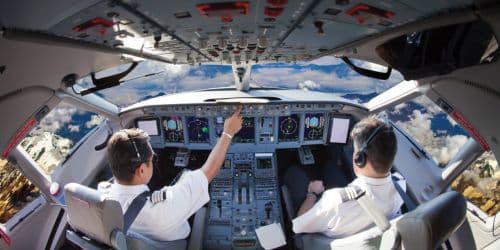Airline pilots are generally known to fly and operate aircraft like planes and helicopters. And because of the current pilot shortage, the Bureau of Labor Statistics also predicts a higher-than-average increase in demand for airline pilots through 2030. Therefore, whether you currently have a private pilot license or are just looking into this field, there are several levels of certification and flight training you’ll need to complete and requirements to meet before you can apply for a job either as an airline pilot with a regional or commercial airline. Read on to learn all you need to know about the requirements to become an airline pilot in regards to the United, Delta, Turkish as well as commercial airlines.
What is an Airline Pilot?
An airline pilot is in charge of flying an aircraft that transports people and goods from one place to another. The responsibilities of an airline pilot include performing pre-flight instrument checks, taxiing the plane to and from the gate and around the runway, taking off and landing, and safely transporting passengers and cargo. You have to be able to fly in all kinds of conditions, day or night, with complete confidence if you want to be a pilot.
What Does an Airline Pilot Do?
Transporting passengers as well as other flight attendants from one location to another is the primary duty of an airline pilot. They’re in charge of the plane’s movement and flight path and must use sophisticated tools to do so. To guarantee a safe flight, the captain along with the first officer in the cockpit work together on everything from preflight checks and flight records to take-off as well as landing coordination.
In other words, piloting a multi-engine aircraft involves a high level of technical expertise, which airline pilots must possess. They are the ones that have to control the plane through bad weather and deal with any mechanical issues that crop up while in the air. To navigate safely, airline pilots generally rely on radar and radio communications with air traffic controllers.
Airline Pilot Requirements
Obtaining the certificates (private pilot first, then commercial pilot) and ratings (instrument, multiengine) requires you to engage in commercial flight operations as the end goal of flight training, which entails both in-flight and ground-based instruction.
To guarantee that a pilot entering any airline service (Delta United, Turkish) are prepared to provide the greatest level of safety and competence, the FAA has established the following requirements.
FAA Minimum Qualification and Flight Experience Requirements
To serve as a first officer in airline operations:
- Be at least 21 years old
- possess an instrument rating and either an Air Transport Pilot (ATP) certificate or an ATP certificate with restricted privileges (R-ATP).
- Suitable aircraft type rating
- A second-class medical certificate, at the very least
To obtain an ATP certificate with a multiengine class rating and airplane category:
- Completely comply with all prior (i.e., “before FOQ rule”) standards.
- You must successfully finish an ATP certification training course before taking the ATP knowledge test.
- 50 hours or more in a class of aircraft, such as a multiengine,
- Satisfies all FAR criteria
Requirements o obtain a restricted-privileges ATP certificate:
- Be at least 21 years old
- Possess a commercial pilot’s license with an instrument rating.
- To take the ATP knowledge test, you must first pass the ATP CTP.
- Passing both the written and practical tests for ATP
- Satisfy the requirements for aviation experience in Section 61.159. A pilot may be qualified if they have completed 750 hours of flight time as a military pilot, 1,000 hours of flight time as a graduate of a four-year bachelor’s program with an aviation major, 1,250 hours of flight time as a graduate of a two-year associate program with an aviation major, or 1,500 hours of flight time overall.
- Meet the FAR requirements
To participate in operations as the pilot in command:
- Meet every prerequisite from earlier (i.e., “before FOQ rule”)
- As second in command in operations meet a minimum of 1,000 flying hours in air carrier operations.
How to Become a Pilot for an Airline
These stages explain the typical route and requirements to completing the necessary training and gaining expertise in order to become an airline pilot, either regular or commercial for Delta, United, or Turkish airlines
#1. Obtain an FAA-Approved Bachelor’s Degree
When applying for positions as an airline pilot, the majority of big airline firms need a bachelor’s degree in aviation or a closely related discipline. The most typical course of action for students who want to pursue a career as an airline pilot is to enroll in an FAA-approved university where they can take aviation-related courses to both acquire a degree and start their pilot training simultaneously.
Your ultimate objective of becoming an airline pilot might be directly attained with the aid of this path. The fact that most FAA-approved colleges and universities offer pilot training as an integral part of their aviation programs is a significant perk of attending one of these institutions. They are able to offer students a wide range of training tools, specialized facilities, and greater scheduling flexibility for flight hours.
#2. Get Your Private Pilot’s License
You must study fundamental flight techniques, aircraft movements, navigation, flight planning, and emergency training to obtain a private pilot certificate or pilot’s license. You can legally fly an aircraft once you get this certification. Earning this certificate allows pilots to practice small-plane flying independently.
#3. Obtain an Instrument Rating
Reading and using instruments are required when flying for an airline. After receiving your basic pilot’s license, you will need to learn how to utilize complex instruments that direct an aircraft through various weather conditions and heights. The National Airspace System and air traffic control are also covered in this certification’s training for pilots.
#4. Get Your Flight Instructor’s License
Many pilots decide to become flight instructors in order to increase their experience and flight time. Pilots are able to accrue pay while logging hours. Before you are even eligible for the position of the first officer, the majority of airlines demand a minimum number of flight hours. The fastest method to amass the flight hours and experience required to work as an airline pilot is to become a flight teacher.
#5. Obtain a Commercial Pilot License
A commercial pilot’s license enables pilots to transport people or commodities for pay. After obtaining this qualification, a pilot can work in search and rescue, passenger flights (which might include corporate or leisure flights), and freight deliveries. A pilot falls into this category if they wish to get ratings for each type of aircraft they wish to fly. They might, for instance, upgrade their single-engine commercial pilot certificate to include a multi-engine rating.
#6. Obtain Your Qualification as an Airline Transport Pilot.
The highest license that the FAA awards is an airline transport pilot (ATP) certification. Pilots need more than the bare minimum of 1,500 flying hours to obtain this certification. Additionally, certain flight hours, such as pilot in command (PIC), night flying, and cross-country PIC, must be reported by pilots.
Future airline pilots must also undergo medical exams in order to obtain an ATP certification. To serve as a pilot in command or as second in command, a pilot must pass a first-class medical examination.
#7. Gain Knowledge and Flight Hours
You need to fly for a lot of hours before you can become an airline pilot. The FAA stipulates that a pilot must have 1,500 total flying hours. Through training sessions, flight instruction, and employment as a commercial pilot, you can achieve this.
#8. Add a Multi-Engine Rating
Pilots must get an additional rating in addition to having a commercial license in order to be able to pilot the aircraft used by passenger carriers. The ability to control a large aircraft with many engines must be demonstrated by the pilot. Learning what to do in the event of a single-engine failure and operating these enormous aircraft in all facets of flight is part of the training for this certification.
#9. Interviews to Become a Pilot for an Airline
You can look for work with a significant airline once you have satisfied all FAA standards. Since seniority is the basis for hiring on airlines, you’ll begin as a first officer and advance to captain after at least two years of employment.
Is Airline Pilot a Good Career Path?
Employment of airline pilots is expected to rise at a far slower rate (less than 10 percent) than most other occupations between 2016 and 2026, according to the US Bureau of Labor Statistics. It’s a competitive field because most vacancies only become available after present personnel retires. Although aviation school isn’t cheap, the benefits of your profession include frequent domestic and international travel.
What Is the Difference Between a Commercial Pilot and an Airline Pilot?
Airline pilots generally start out as commercial pilots, gaining experience as flight instructors or charter pilots. The tasks they are employed to perform distinguish commercial pilots from airline pilots. While commercial pilots transport passengers and cargo, conduct reconnaissance, and meet other flight requirements relevant to their job descriptions, airline pilots frequently work for a particular regional airline.
What Are the 3 Types of Pilots?
While there are numerous certifications issued every year under which we can categorize pilots, here are the 3 basic types;
- Airline Transport Pilot
- Commercial Pilot
- Private Pilot
How Long Does It Take To Be an Airline Pilot?
The majority of training programs will generally allow one to become certified as an airline pilot within two years. However, to be considered for a position as an airline pilot, you might need more flight time and experience.
Which Type of Pilot Is Best?
The most advanced pilot license available is the airline transport pilot (ATP), which is necessary for anyone who wants to fly commercial airplanes for a living. A pilot applicant must possess an ATP certificate in order to work for any commercial airline.
How Many Hours Do Pilots Work?
On average, airline pilots spend 75 hours a month in the cockpit and another 150 hours on the ground doing things like monitoring the weather and making flight plans. It’s not uncommon for pilots to work some days followed by alternating days off due to their erratic work schedules.
Which Type of Pilot Earns the Most?
Here are the highest-paying pilot jobs:
Government service pilot: $202,180 per year
- Military pilot: $202,180 per year
- Ambulatory pilot: $134,630 per year
- Helicopter pilot: $134,630 per year
- Agricultural pilot: $84,372 per year
- Airline transport pilot: $84,372 per year
- Cargo pilot: $63,988 per year
- Flight instructor: $66,373 per year
Which Country Is Cheapest for Pilot Training?
The Philippines is one of the least expensive countries in the world to train as a pilot and obtain a pilot’s license. In this nation, students can often finish their coursework for about INR 9–10 lakh. In this regard, Australia, like Poland and Nigeria, is also quite inexpensive.
Commercial Airline Pilot Requirements
The Federal Aviation Administration (FAA) issues airline transport pilot licenses to those who wish to fly for commercial airlines. To apply for this license, you must be 18 years of age or older. In addition to the minimum flight time and medical requirements, pilots are also expected to pass a written and flight exam. In order to stand out in today’s competitive employment market, you might need to further your education past high school.
Flight Time Requirement
To be eligible for an FAA airline transport license, a pilot must have logged at least 1,500 hours in the cockpit. A portion of this time in the air must be spent navigating in limited visibility conditions and flying at night using instruments. Pilots gain the necessary flying time through several means, including formal education, time spent in the armed forces, time spent flying for hire, and time spent flying for themselves.
The Federal Aviation Administration Exam
The FAA test includes a written section that covers topics including navigation, rules, and safety. In addition to the written section, there is a practical demonstration of abilities required by the exam administrators.
Health Requirements
An airline Pilot also has health requirements to meet which show they are physically and mentally fit to fly. Hence, pilots need to pass a physical check proving they have normal hearing and vision and no other physical limitations that could compromise their ability to fly safely. In order to ensure that their pilots can make decisions even when under duress, many airlines also administer psychological and aptitude tests.
Educational Requirements
Airline pilots are generally required to have a bachelor’s degree and an Airline Transport Pilot (ATP) license. However, commercial pilots typically just need a high school diploma or its equivalent, as reported by the U.S. Bureau of Labor Statistics. Independent instructors or flight schools are two options for obtaining flight instruction.
Bottom Line
Although significant improvements in aviation technology have significantly increased safety, the flight crew is still in charge of making hundreds of decisions on each flight to ensure the highest level of safety.
The first step in becoming a highly accomplished pilot, however, starts in an aviation-focused training environment, such as a university aviation school, the military, or another sort of training environment,
While there are a number of requirements that you might need to meet, obtaining the certificates is a necessity to engage in any commercial airline (Delta, United, or Turkish) operations and is the end goal of flight training, which entails both in-flight and ground-based instruction.
Related Articles
- WHAT DAY ARE FLIGHTS CHEAPEST TO BOOK? All You Need To Know.
- FLIGHT MANAGEMENT SYSTEM FMS: Definition, Features and Benefits
- BEST DAY TO BUY AIRLINE TICKETS: Do Prices Go Down on Tuesday?
- CAL GRANT A: Applications, Requirements, Eligibility, Amount, Comparisons






